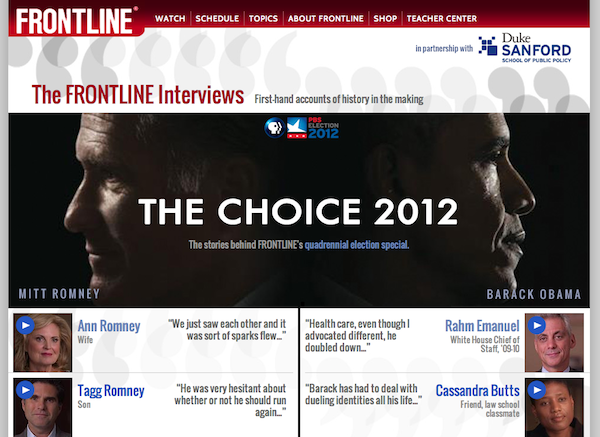

In terms of online video, Frontline got to the scene early, making full episodes of the show available on the web back in the mid-1990s. Now the documentary series is experimenting with their online repository of video to try to orient itself for a future beyond television.
Frontline’s latest program, The Choice 2012, is a biographical look at Mitt Romney and Barack Obama on the eve of the presidential election. In the process of producing the documentary, Frontline did more than 100 interviews, many more than could fit within the broadcast confines of the show. Instead of just dumping the raw footage or selected clips online, the Frontline staff produced 16 videos for the web, over 8 hours of footage, each with an interactive transcript of the conversation. The project was possible through funding from Duke’s Sanford School of Public Policy. (Philip Bennett, the former Washington Post managing editor, is both Frontline’s managing editor and a Sanford professor; Sanford is home to the Jay Rutherfurd Living History Program, for which this will serve as a special collection.)
They’re calling the videos oral histories rather than interviews. Disaggregated from the narrative of the documentary itself, the videos, each running 30 minutes plus in length, feel like a one-on-one conversation rather than a piece of a candidate profile. It’s a sitdown with Ann Romney or Rahm Emanuel, in their own words.
Frontline’s online materials have always been a support to the main broadcast, but now they want to find more dynamic ways of using the video footage and transcripts. “This site creates a nontraditional form of storytelling,” said Andrew Golis, Frontline’s director of digital media. The transcript and video are meant to work either in concert or separately, with video cues tied to various parts of the written transcript. A viewer has the option of reading the transcript and jumping to points in the video, or watching the whole thing from start to finish. Golis said tying the two together has a powerful contextual effect, being able to hear someone talk but also see their exact words.
Sarah Moughty, Frontline’s assistant managing editor for digital, said The Choice, the series’ long-running election special, is designed to provide a more personal narrative on presidential candidates. That made it the right fit for the new interactive video treatment, she said. “There’s something compelling to just sitting back and listening to the guy that went on mission to France with Romney, or Obama’s roommate in New York,” Moughty said.
Though Frontline’s has a history of making video available online, it typically consists of the entire program, selected clips, or a few extended interviews. Moughty said this project went further because the video was edited and produced specifically for an online audience — “We’ve never done it on this scale before,” she said.
So how will viewers find it? Prompts during TV broadcasts of The Choice 2012 direct viewers to the site, and Golis said they plan to use Facebook and Twitter to drive people to the videos as well. (A related project to assemble candidate-related artifacts online got some social media traction and used Branch as a discussion platform.) But Golis told me he sees the videos reaching the widest audience through online search: “We want people who search for Tom Topolinski, when they read about him in David Remnick’s book five years from now, to find this interview.”
In the last year, Frontline has been spending more time thinking about its future and the future of documentary film. In July the program promoted Raney Aronson to deputy executive producer, making her a possible successor to David Fanning, Frontline’s executive producer.
In April, Frontline pulled together a quiet little confab with more than 30 people from places like The Washington Post, Mozilla, The New York Times, MIT, the National Film Board of Canada, and various corners of public media. The idea behind the meeting was to imagine what Frontline’s storytelling will look like in the near and distant future. One of the questions to come out of the gathering was how documentary producers can take advantage of the web or tablets to expand their storytelling beyond an hour-long film.
Like countless broadcast producers, Frontline wants to win with online video in a way that doesn’t lessen its television work or fragment the audience. They’re also enticed by the promise of tablets, a new output that can recapture some of the intimacy of TV while offering a new layer of engagement.
Golis said the oral histories project is a step towards the future where storytelling can be linear or nonlinear. He said the goal is to give the audience the ability to seamlessly move between something on broadcast and something more immersive on the web. “I think on some level this is a piece of infrastructure that will reinforce a lot of different things,” Golis said.